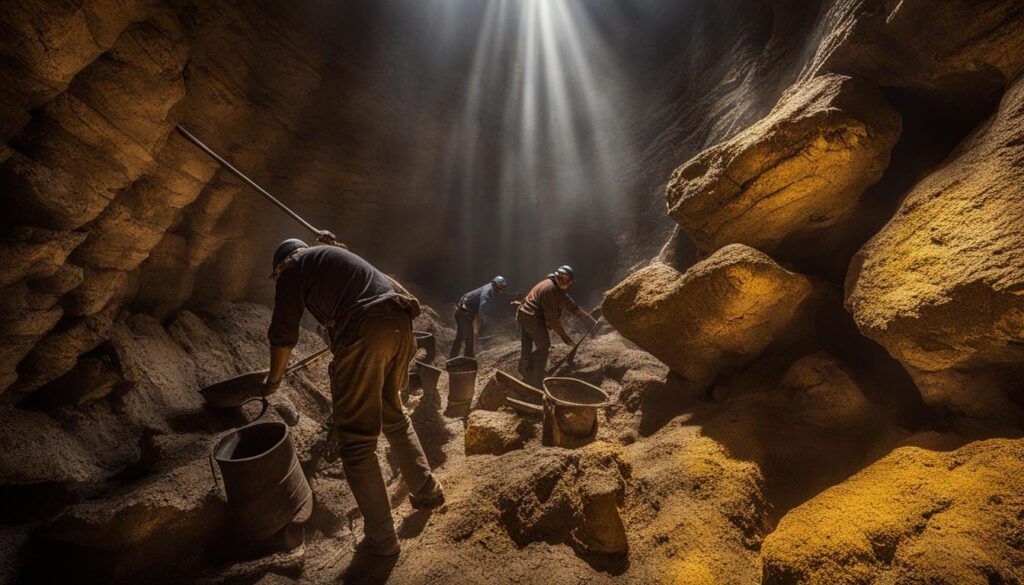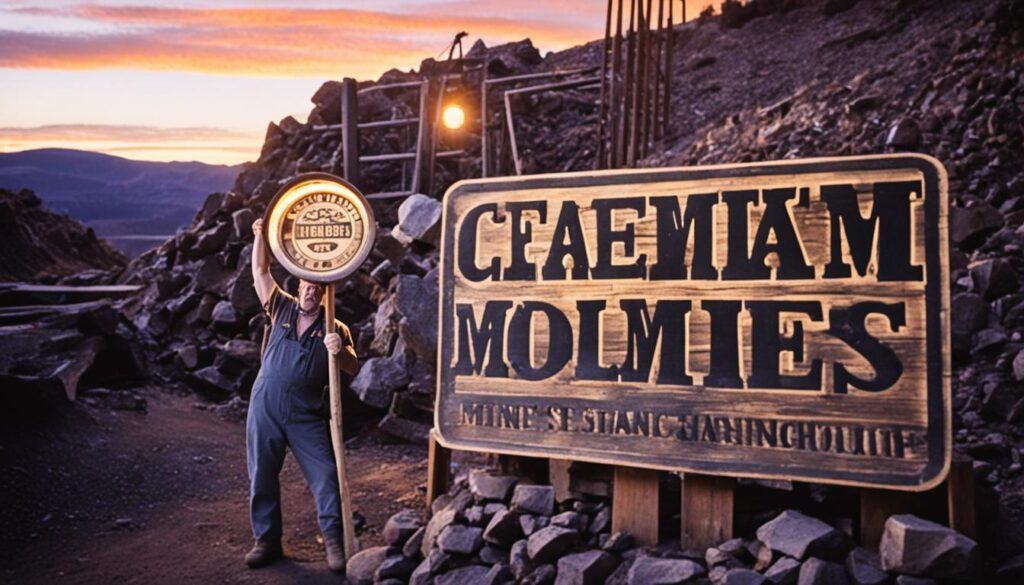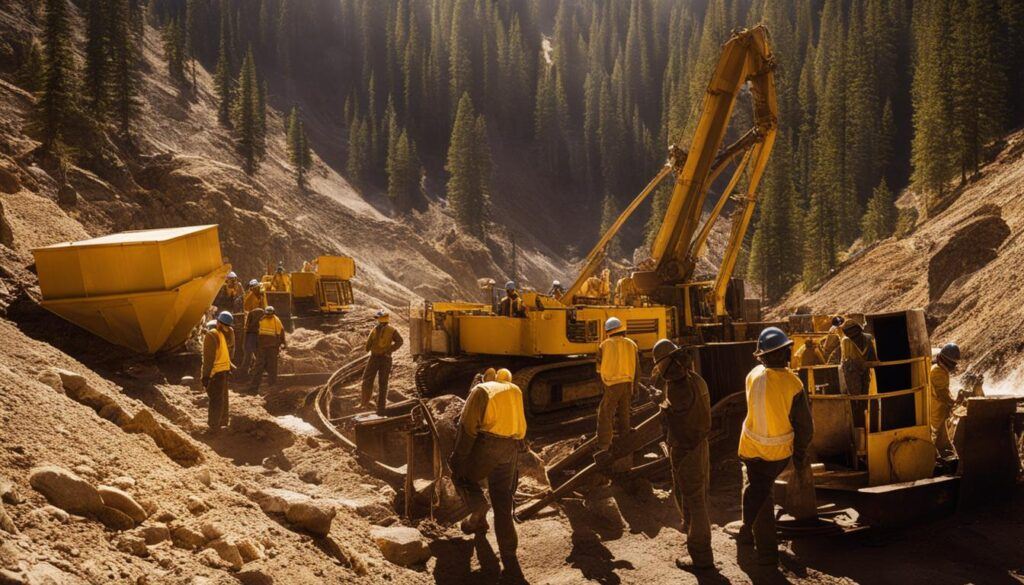When it comes to the history of gold, one question that often arises is: Where was gold first discovered in the United States? The answer to this question takes us back to the late 18th century, to a small farm in Cabarrus County, North Carolina.
It was here, in 1799, that a young boy named Conrad Reed made a chance discovery that would change the course of American history. While playing along Little Meadow Creek on his father’s farm, Conrad came across a gleaming gold nugget. Little did he know that this humble find would go on to spark the first gold rush in the United States, known as the Carolina Gold Rush.
At first, the significance of Conrad’s discovery went unnoticed. It wasn’t until 1802 that his father, John Reed, took the gold nugget to a jeweler in Fayetteville. To their surprise, the jeweler confirmed that the nugget was indeed gold, setting off a frenzy of excitement in the region.
Word quickly spread, and people from all walks of life flocked to North Carolina in search of their own fortunes. The Reed family, recognizing the potential of their land, organized a small mining operation. By 1824, these part-time miners had already recovered an estimated yield of $100,000 worth of gold.
Today, the Reed Gold Mine is a site of historical significance, a reminder of the origins of gold mining in the United States and the impact it had on the country’s development.
Key Takeaways:
- Gold was first discovered in the United States at Reed farm in Cabarrus County, North Carolina, in 1799.
- The discovery sparked the Carolina Gold Rush, the first gold rush in the United States.
- The Reed Gold Mine became a significant mining operation and yielded an estimated $10 million worth of gold before 1853.
- The discovery of gold in North Carolina paved the way for further gold rushes in other states, such as the famous California Gold Rush in 1848.
- The history of gold mining in the United States shaped the nation’s economy and development.
The History of Gold
Gold has a rich and fascinating history that spans thousands of years. It has captivated and influenced civilizations around the world, leaving a lasting impact on culture, economy, and trade. Let’s delve into the captivating journey of gold through time, exploring its origins, important discoveries, and mining techniques.
Origins of Gold
The earliest known use of gold dates back to around 4000 B.C. in Eastern Europe, where it was used to create decorative objects. The Sumer civilization in southern Iraq, around 3000 B.C., extensively used gold for jewelry. However, it was the Egyptians who truly mastered the art of gold jewelry-making. They even invented the lost-wax casting technique to create intricate gold ornaments.
Gold as a Medium of Exchange
During the ancient Egyptian civilization, gold became the recognized standard medium of exchange for international trade. Its value and rarity made it desirable for transactions and helped facilitate economic growth. The Egyptians established trade routes that extended their influence across the known world, spreading the use of gold as a form of currency.
Important Gold Discoveries
Throughout history, there have been numerous significant gold discoveries that ignited gold rushes and shaped the course of gold mining. From the ancient gold mines of Nubia and the Roman Empire to the more recent discoveries in the United States, gold has incited excitement and fueled prosperity.
“Gold mining has been a driving force behind numerous historical events, from the colonization of regions to the rapid development of mining communities. Its allure continues to captivate miners and enthusiasts alike.”
Evolution of Gold Mining Techniques
Over time, gold mining techniques have evolved, adapting to the geological landscapes and technological advancements. From ancient civilizations utilizing primitive methods to modern industrial practices, each era has contributed to refining the art of extracting gold from the earth.
- Placer mining: Involves the extraction of gold from rivers and streams, using pans or sluice boxes to separate gold particles from sand and gravel.
- Hydraulic mining: Utilizes high-pressure water jets to erode hillsides, revealing gold-bearing gravels.
- Lode mining: Focuses on extracting gold from veins and deposits embedded within rock formations.
The combination of these techniques, along with advancements in machinery and technology, has led to more efficient and productive gold mining operations throughout history.
Gold Mining in Ancient Times
In ancient times, gold mining was a significant activity in various civilizations around the world. These civilizations mastered gold mining techniques and developed technologies that were groundbreaking in their time. Let’s explore some of the ancient gold mining civilizations, their techniques, and the regions rich in gold deposits.
Ancient Gold Mining Civilizations
Nubia, an ancient kingdom located in present-day Sudan, was renowned for its vast gold-bearing regions that made Egypt a prosperous nation. The Nubians used advanced techniques to extract gold from rivers and streams, employing methods such as panning and sluicing to separate gold particles from sediment.
“Nubia’s gold reserves were so abundant that it propelled Egypt into immense wealth.”
Another notable civilization in ancient times that embraced gold mining was Babylon. The Babylonians developed the fire assay method, a technique used to determine the purity of gold. This innovative method involved heating the gold and observing the color changes to assess its quality and value. The fire assay method revolutionized gold analysis during that era.
Ancient Gold Mining Techniques
The Greeks and Jews in ancient Alexandria pursued alchemy, an intricate practice that aimed to transmute base metals into gold. Although alchemy’s ultimate goal may have been elusive, these ancient scientists made significant progress in understanding the properties of gold and other metals.
The Romans, known for their civilization’s advancements, also recognized the significance of gold mining. Gold served as a form of currency in ancient Rome, facilitating trade and commerce throughout the empire. Additionally, the Romans used various mining techniques to extract gold, including underground mining and hydraulic mining, which involved using water to dislodge gold-bearing rocks and sediment.
Gold-Bearing Regions
Gold mining civilizations identified and exploited gold-bearing regions, which were rich in this precious metal. Nubia’s gold-bearing regions along the Nile River were a prime location for gold extraction, providing a constant supply of gold to ancient civilizations.
“The abundance of gold in regions like Nubia fueled the wealth and prosperity of ancient civilizations.”
In addition to Nubia, other regions known for their gold-bearing deposits include ancient Egypt, Greece, Rome, and ancient Persia. These areas were significant contributors to the gold trade in ancient times.
Gold Mining Technologies
Throughout ancient times, civilizations developed innovative technologies to enhance their gold mining operations. For example, Venice introduced the gold Ducat, a coin that gained popularity and widespread use for over five centuries. The introduction of the gold Ducat revolutionized the exchange of goods and services, facilitating economic growth and trade.

In summary, gold mining in ancient times played a crucial role in various civilizations’ economies and societies. Through their innovative techniques and technologies, these civilizations harnessed the abundance of gold from regions such as Nubia, Egypt, and Persia. The advancements in gold mining techniques and the recognition of gold’s value as a form of currency fostered economic growth, trade, and prosperity in ancient times.
| Gold Mining Civilizations | Ancient Techniques | Gold-Bearing Regions | Technologies |
|---|---|---|---|
| Nubia | Panning, sluicing | Nile River, Eastern Sahara | – |
| Babylon | Fire assay method | Mesopotamia | – |
| Greeks, Jews in Alexandria | Alchemy | – | – |
| Rome | Underground mining, hydraulic mining | Italy, Iberian Peninsula | – |
| Venice | – | – | Gold Ducat |
Gold Mining in the United States
Gold mining in the United States has a rich history that dates back to the late 18th century. It all began with the discovery at the Reed farm in North Carolina in 1799, which ignited the Carolina Gold Rush and marked the start of gold mining operations in the region. At that time, North Carolina became the leading producer of gold in the United States.
However, the focus shifted westward with the famous California Gold Rush in 1848, attracting prospectors from all over the country. The discovery at Sutter’s Mill sparked a massive influx of people, transforming California into a major gold mining region and changing the course of American history.
Apart from North Carolina and California, there are several other major gold mining regions in the United States. These include Alaska, known for its rich gold deposits and modern mining operations. Alaska has been a significant contributor to total U.S. gold production, showcasing the state’s vast mineral potential.
Colorado is another important gold mining state, with the Pike’s Peak Gold Rush of 1858 leading to the establishment of major mining districts such as the Cripple Creek & Victor Gold Mine. Today, it remains the only active gold mine in Colorado, producing substantial amounts of gold annually.
Georgia also played a significant role in the history of gold mining in the United States. The Georgia Gold Rush in the early 1830s led to extensive mining operations in the Georgia Gold Belt, resulting in noteworthy historical gold production.
Other states, such as Idaho, Florida, and Arizona, also have their contributions to the gold mining history of the United States. Each state boasts unique gold mining districts and notable discoveries that have shaped America’s mining heritage.
Gold Mining Techniques in America
Throughout history, various mining techniques have been employed in the United States to extract gold from the earth. These techniques have evolved as advancements in technology and mining practices have occurred.
Placer mining is one of the earliest and simplest methods used, involving the extraction of gold from rivers and streambeds. Miners would pan for gold or use sluice boxes to separate gold particles from the surrounding sediment.
Hydraulic mining became popular during the California Gold Rush. It involved using high-pressure water jets to wash away hillsides and extract gold-bearing gravel. Although highly efficient, this technique had significant environmental impacts and was eventually banned.
Lode mining is a method used to extract gold from underground deposits. It involves tunnelling into the earth to reach gold-bearing veins or ore bodies. This technique requires advanced equipment and machinery to extract the gold efficiently.
With advancements in technology, such as the introduction of heavy machinery and chemical extraction processes, gold mining in the United States has become more efficient and productive.
Overall, gold mining has played a vital role in shaping the history, economy, and development of the United States. The discovery at the Reed farm in North Carolina, followed by the California Gold Rush and the establishment of mining operations in various states, has left an indelible mark on America’s mining heritage. With ongoing mining activities and advancements in mining techniques, the United States continues to be a significant player in the global gold industry.
The Reed Gold Mine
The Reed Gold Mine in Cabarrus County, North Carolina, holds a significant place in the history of gold mining in the United States. It is where the first documented gold discovery in the country took place, sparking the Carolina Gold Rush and paving the way for gold mining operations in North Carolina.
The discovery at the Reed farm occurred in 1799 when young Conrad Reed stumbled upon a gold nugget while playing along Little Meadow Creek. Unaware of its true value, the nugget went unnoticed until 1802 when Conrad’s father, John Reed, took it to a jeweler in Fayetteville. The jeweler confirmed that it was indeed gold, marking the beginning of an era that would shape the region’s history.
“Young Conrad’s accidental discovery set off a flurry of excitement, attracting many eager prospectors to the area in search of their own fortunes.”
Following the gold discovery, the Reed family organized a small mining operation at the site. By 1824, part-time miners had recovered an estimated yield of $100,000 worth of gold, an impressive sum for the time. The Reed Mine continued to be productive, yielding an estimated $10 million worth of gold before operations ceased in 1853.
The Reed Gold Mine played a crucial role in the Carolina Gold Rush, drawing people from across the country to the region in search of gold. It had a lasting impact on the development of North Carolina and its mining industry.

Reed Gold Mine Facts
| Location | County | First Gold Discovery | Estimated Gold Yield |
|---|---|---|---|
| North Carolina | Cabarrus | 1799 | $10 million (approx. before 1853) |
The Reed Gold Mine’s historical significance and contribution to the gold mining industry cannot be overstated. It stands as a testament to the entrepreneurial spirit and determination of those who sought their fortunes in the early days of American gold mining.
Gold Mining in California
The California Gold Rush, ignited by the discovery at Sutter’s Mill in 1848, stands as a pivotal moment in the history of gold mining in the United States. The allure of gold drew thousands of hopeful prospectors to California, resulting in the rapid growth of mining communities and the establishment of major gold mining districts across the state. Notably, the Mother Lode and Grass Valley-Nevada City emerged as prominent centers of gold mining activity in California.
During its peak in 1852, California experienced a staggering gold production, contributing significantly to the overall output of the United States. However, as the easily accessible gold deposits were depleted, production declined in the subsequent years. Nevertheless, the impact of gold mining in California cannot be understated.
In the quest for gold, mining techniques evolved, with hardrock mining and hydraulic mining taking center stage. Hardrock mining involved the excavation of underground rock formations to reach gold-bearing ores. Hydraulic mining, on the other hand, utilized powerful water jets to dislodge and transport gravel and sediment for gold extraction.
| Major Gold Mining Districts in California | Location |
|---|---|
| Mother Lode | Sierra Nevada foothills |
| Grass Valley-Nevada City | Sierra Nevada foothills |
| Feather River | Yuba and Butte Counties |
| Klamath-Trinity Rivers | Klamath and Trinity Counties |
| Yreka District | Siskiyou County |
The gold mining industry not only shaped California’s landscape but also had a profound socio-economic impact. The influx of gold seekers transformed the region, leading to the establishment of cities, towns, and infrastructure. Moreover, the California Gold Rush played a significant role in the nation’s westward expansion and the development of the American dream.
In summary, the California Gold Rush sparked a wave of gold mining activity, attracting fortune-seekers from far and wide. The establishment of major gold mining districts and the adoption of innovative mining techniques left an indelible mark on California’s history. Today, while gold mining has diminished, California’s rich gold mining heritage continues to be celebrated and revered.
Gold Mining in Alaska
Gold mining in Alaska has a rich history that dates back to the late 1800s during the Alaska Gold Rush. The discovery of placer gold in the Kenai River by Russian explorers in 1848 set the stage for significant gold findings in the 1860s. Since then, Alaska has become a prominent location for gold mining.
The Fort Knox mine, owned by Kinross Gold Corporation, stands as the largest gold producer in Alaska. This modern mining operation utilizes state-of-the-art techniques to extract gold from the region. Additionally, other major gold mines in Alaska, such as the Pogo mine, the Kensington mine, and the Greens Creek mine, contribute to the state’s substantial gold production.
In 2019, Alaska produced 873,984 troy ounces of gold, accounting for 12.7% of the total gold production in the United States. The abundant gold reserves and thriving mining industry make Alaska a significant player in the gold mining sector.

Gold Mining in Colorado
Gold mining in Colorado has a rich history, dating back to the Pike’s Peak Gold Rush in 1858. This major gold rush attracted prospectors from all over, eager to strike it rich. The first significant gold discoveries in Colorado were made in the Central City-Idaho Springs district in 1859. This district became one of the most productive areas in the state, yielding a substantial amount of gold.
During the late 1800s, Colorado experienced a boom in gold mining. Many major gold-producing districts emerged, contributing to the state’s growing reputation as a gold mining hotspot. One notable district is the Cripple Creek & Victor Gold Mine, located in Teller County. This district produced a significant amount of gold and is still actively mined today.
To give you an idea of the scale of gold production in Colorado, let’s take a look at the Cripple Creek & Victor Gold Mine. In 2018, this mine produced an impressive 360,000 troy ounces of gold. It remains the only active gold mine in Colorado, highlighting the importance of this region in the state’s mining industry.
The Colorado Gold Rush and the subsequent gold mining activities played a significant role in the state’s development and economy. Today, Colorado continues to be a destination for gold enthusiasts, with opportunities for recreational gold panning and prospecting in various areas.
Gold Mining in Idaho
Idaho has a rich history of gold mining, with notable discoveries and major mining districts contributing to the state’s gold production. From the early days of gold prospecting to the present, Idaho has played a significant role in America’s gold mining industry.
The first documented gold discovery in Idaho occurred in 1860 in Pierce, a small town located in the northern part of the state. This discovery sparked the interest of prospectors, leading to further exploration and the establishment of mining operations in the region.
One of the most significant gold-producing districts in Idaho is the Boise Basin, which was discovered in 1862. The Boise Basin became the leading historical gold-producing district in the state, with substantial production from placer deposits. Miners flocked to the area, and numerous mining towns sprang up, fueling economic growth and expansion in Idaho.
In addition to the Boise Basin, there are other notable gold mining districts in Idaho. The French Creek-Florence district, located in central Idaho, has been a productive area known for both placer and lode gold deposits. The Silver City district in southwestern Idaho also has a rich mining history and has contributed to the state’s gold production.
Idaho’s gold production has primarily come from lode deposits, which are veins of gold embedded within rocks. However, there has also been some byproduct production of gold from silver mining operations in the state.
| Gold Mining District | Location | Primary Deposits |
|---|---|---|
| Boise Basin | Central Idaho | Placer deposits |
| French Creek-Florence | Central Idaho | Placer and lode deposits |
| Silver City | Southwestern Idaho | Lode deposits |
Idaho continues to be a significant contributor to the gold mining industry in the United States. The state’s rich mining history and diverse gold deposits make it an attractive destination for gold prospectors and mining companies.
Gold Mining in Georgia
Georgia holds a significant place in the gold mining history of the United States. In the early 1830s, the Georgia Gold Rush was ignited by the discovery of gold in the state. This momentous event led to the establishment of extensive gold mining operations within the Georgia Gold Belt, a geological region known for its abundant gold deposits. From 1830 to 1959, Georgia’s historical gold production is estimated at an impressive 871,000 troy ounces.
During the Georgia Gold Rush, numerous individuals flocked to the region in search of wealth and fortune. The Georgia Gold Belt, stretching across present-day Georgia, was a hotbed of activity as prospectors and miners dug deep to extract the precious metal. The thriving gold mining industry in Georgia contributed significantly to the economic development of the state and played a vital role in the growth of mining communities.
The gold mining history of Georgia is intertwined with stories of perseverance, determination, and the pursuit of a better life. Miners braved challenging conditions to extract gold from the earth, often using primitive methods and tools. Their efforts resulted in the accumulation of a substantial amount of gold, contributing to the nation’s overall gold production.
The Georgia Gold Rush
The Georgia Gold Rush, similar to other gold rushes in the United States, brought about significant changes to the region. It attracted people from various parts of the country, creating a melting pot of cultures, and fostering economic growth. As news of the gold discovery spread, thousands of prospectors arrived in Georgia, hoping to strike it rich.
Gold mining in Georgia played a crucial role in the state’s early history. It brought about advancements in infrastructure, such as the construction of roads, bridges, and settlements, which supported the growing mining operations. The Georgia Gold Rush also had a lasting impact on the demographic and social makeup of the state, leaving a lasting legacy.
Major Gold Mines in Georgia
| Mine Name | Location | Years of Operation |
|---|---|---|
| Dukes Creek Gold Mine | White County | 1848-1853 |
| Cherokee County Gold Mine | Cherokee County | 1849-1854 |
| Temple Mine | Carroll County | 1878-1884 |
| Briggs Mine | DeKalb County | 1890-1907 |
Though the gold rush in Georgia eventually subsided, the impact of the gold mining industry is reflected in the state’s rich history. Today, Georgia continues to be home to various gold mining sites, and enthusiasts have the opportunity to explore the remnants of the industry that once shaped the state’s landscape.
Gold Mining in Other States
Gold mining in the United States extends beyond the well-known gold rush locations. Several other states have contributed to the country’s rich history of gold production and notable discoveries. Let’s explore some of these lesser-known gold mining regions:
Alabama
Though not widely recognized for its gold mining activity, Alabama had limited commercial gold mining in the past. The Arbacoochee and Hog Mountain districts were the primary areas of interest for gold miners in the state.
Florida
Florida had its fair share of small-scale gold mining during the late 19th Century. The site of what is now Mike Roess Gold Head Branch State Park was a notable location for gold extraction.
Arizona
Arizona boasts a rich gold mining history, with major districts that have contributed to the state’s overall gold production. The San Francisco district and the Rich Hill district are recognized for their significant gold mining activity.
While these states may not be as renowned as California or Alaska in terms of gold mining, their contributions have played a small but important role in the country’s gold production. Each location has its unique history and showcases the diversity of gold mining throughout the United States.

Image: Gold mining operations in other states have made important contributions to the overall gold production in the United States.
Conclusion
Gold mining has played a significant role in the history and development of the United States. From the first documented gold discovery in North Carolina to the famous California Gold Rush and the ongoing gold mining operations in Alaska, Colorado, and other states, gold has shaped the nation’s economy and development. The United States continues to be one of the top gold-producing nations in the world, with significant contributions from various states. The rich history and ongoing mining activities make gold a valuable and enduring resource in the United States.
FAQ
Where was gold first discovered in the United States?
Gold was first discovered in the United States at the Reed farm in Cabarrus County, North Carolina, in 1799.
What is the history of gold mining?
Gold has been used by human civilizations for thousands of years, with the earliest known use of gold dating back to around 4000 B.C. Various civilizations such as the Egyptians, Babylonians, Greeks, Romans, and Venice have all played a role in the history of gold mining.
What are some notable gold mining techniques in ancient times?
Ancient civilizations practiced various gold mining techniques, including placer mining, hydraulic mining, and lode mining. The Greeks and Jews in ancient Alexandria also practiced alchemy, the quest to turn base metals into gold.
Where did gold mining first occur in the United States?
The first documented gold discovery in the United States occurred at the Reed farm in Cabarrus County, North Carolina, in 1799. This sparked the Carolina Gold Rush and led to the establishment of mining operations in the region.
What is the Reed Gold Mine?
The Reed Gold Mine in Cabarrus County, North Carolina, is the site of the first documented gold discovery in the United States. It played a significant role in the Carolina Gold Rush and yielded an estimated million worth of gold before 1853.
What were the major gold mining districts during the California Gold Rush?
The California Gold Rush led to the establishment of major gold mining districts such as the Mother Lode and Grass Valley-Nevada City.
What are some major gold mines in Alaska?
Major gold mines in Alaska include the Fort Knox mine, the Pogo mine, the Kensington mine, and the Greens Creek mine. The state of Alaska is a significant contributor to gold production in the United States.
What were the major gold mining districts in Colorado?
The Central City-Idaho Springs district and the Cripple Creek & Victor Gold Mine were among the major gold mining districts in Colorado.
Where were notable gold discoveries made in Idaho?
Notable gold mining districts in Idaho include the Boise Basin, the French Creek-Florence district, and the Silver City district.
What was the Georgia Gold Rush?
The Georgia Gold Rush occurred in the early 1830s after gold was discovered in the state. The Georgia Gold Belt became the site of extensive gold mining operations.
Was gold mining limited to specific states in the United States?
No, gold mining has taken place in several states across the United States, including Alabama, Florida, and Arizona, each contributing unique contributions to the overall gold mining history of the country.
What is the conclusion of gold mining in the United States?
Gold mining has played a significant role in the history and development of the United States. From the first documented gold discovery in North Carolina to major gold rushes in California and Alaska, gold has shaped the nation’s economy and development.



